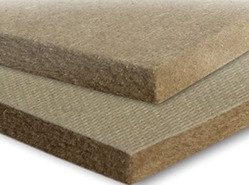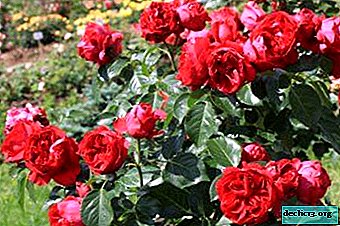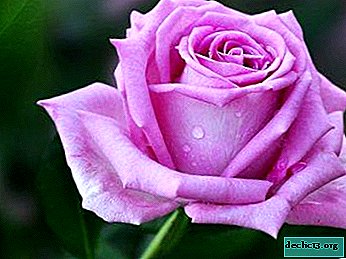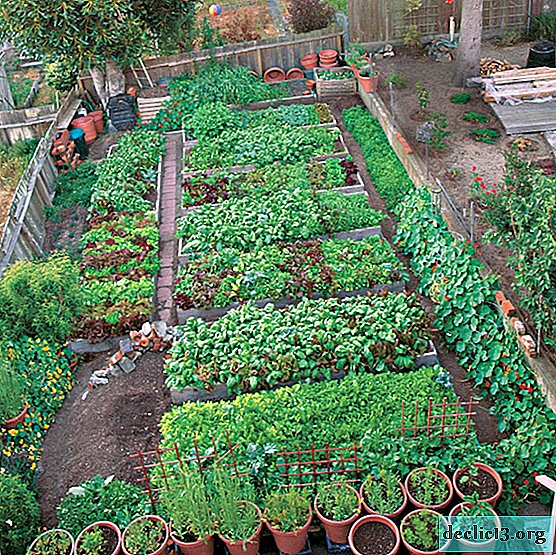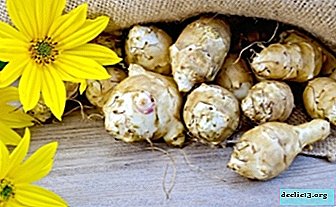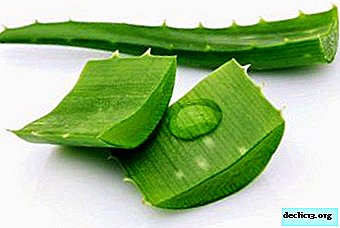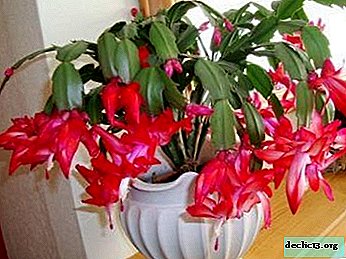Yarrow - benefit, harm, traditional medicine

Yarrow is a widespread herb with a unique set of healing properties. In the people it is called a tree, a bloodsucker, a walker. The topic of conversation will be yarrow - useful properties and contraindications.
Contrary to the name, the plant has a small number of lanceolate leaves, which are strongly dissected. The lower side of the leaves is covered with oil glands, the contents of which have a pronounced pleasant smell.
White or pink flowers of the plant form baskets, combined into a massive corymbose inflorescence. Yarrow fruit is a silver-gray achene with an oblong shape. The fruit ripens in September.
The medicinal plant is common in Eurasia. It grows everywhere on Russian territory, except for the Arctic deserts. You can meet the plant on the shore of a pond, forest edge, on the side of the road or in a forest meadow.
In herbal medicine, there were applications for both flowers and yarrow tops. Raw materials are dried under a canopy, spread out in a five-centimeter layer on paper. In industrial harvesting, bales are made from raw materials. They store dry yarrow grass for 2 years, and inflorescences for 5 years.
Useful and medicinal properties of yarrow

More than a hundred varieties of the herb in question are growing on the planet, but in medicine the yarrow is mainly used. This is due to the high concentration of substances that contribute to the healing of the body. The incredible useful and medicinal properties of the plant are due to the composition, rich in important components. It consists of:
- Tannins. Provide a bactericidal effect and are indispensable in inflammatory processes.
- Carotene. Once in the blood, carotene accelerates the production of vitamin A, which has a beneficial effect on the growth rate, tissue repair, strengthening of nail plates and hair.
- Alkaloids. Indispensable for the treatment of people with poor blood coagulation.
- Silicon. Thanks to this substance, yarrow has antiseptic properties, the ability to heal burns, wounds and cuts.
- Vitamin "K". Strengthens the walls of blood vessels and increases blood coagulation. Vitamin A makes grass incredibly effective for bleeding.
- Vitamin C. Strengthens the immune system, making it much easier for the body to independently fight diseases.
- Resins. They help the body fight microbes and give the grass a pronounced aroma.
Yarrow was widely used in modern medicine. The plant helps to cope with the following pathologies:
- Bleeding. Thanks to its unique composition, the grass strengthens capillaries and blood vessels, increases the rate of blood coagulation. The therapeutic effect is not accompanied by the formation of blood clots.
- Colitis, gastritis, ulcer. The plant normalizes the acidity of the stomach, activates metabolism, improves digestion and increases appetite.
- Liver disease. Substances contained in ordinary yarrow help to cleanse the bile ducts and improve the flow of bile.
- Skin disorders. Grass strengthens the skin, accelerates wound healing, helps with boils and abscesses.
- Women Health. The plant normalizes the microflora, enhances the production of mother's milk, has an analgesic effect during menstruation.
- Colds. Yarrow is highly effective against colds and coughs, makes breathing easier, and speeds up sputum removal.
Agree, the yarrow really has a lot of useful properties. It benefits the body only when used correctly, and only after consulting a specialist.
Contraindications and harm yarrow

Contrary to numerous useful properties, yarrow has contraindications. It is allowed to be used inside only if the dosage is strictly observed. Prolonged and intensive use of herbal medicines causes dizziness and skin rashes.
Yarrow contraindications are extremely unusual.
Before using the medicine, be sure to consult an experienced herbalist and a certified doctor.- The main danger of the herb in question lies in its strength. Leaves and flowers are rich in volatile substances and poisons, which, when overdosed, cause serious harm. Therefore, increasing the dose is not recommended.
- If you decide to try the plant for the first time in practice, do not delay the treatment. The duration of the treatment course is a maximum of 2 weeks. In the absence of problems, terms can be increased.
- Use herbal medicines with caution if you have low blood pressure or a tendency to thrombosis. In this case, seek the support of a physician conducting ongoing monitoring. During pregnancy, it is not worth using field grass for treatment.
- It is better to refuse the use of infusions and decoctions of yarrow with allergies or individual intolerance. Often the plant becomes a delay in menstruation.
Ideally, the plant should be taken under the supervision of a herbalist, who can determine the correct dosage taking into account the characteristics of the body and existing health problems. It is important that the harvesting of raw materials be carried out in an ecologically clean area, since contaminated grass does only harm.
Remember, a medicinal plant is an auxiliary tool, not a substitute for a classic treatment.The use of yarrow in traditional medicine

Since ancient times, people have been using yarrow to treat disease. According to historians, the Romans did not go on a military campaign without this plant. Each military camp was attended by people who sowed grass so that it was always at hand.
From the point of view of medicine, baskets, leaves and stems of grass are considered the most valuable. They are rich in organic acids, tannins, carotene, alkaloids, volatile, resins, copper and other substances necessary for the human body. I will consider the use of yarrow in traditional medicine, depending on the disease.
- Diseases of the stomach and pancreas. To restore health, make an herbal collection. Yarrow and St. John's wort grass, wild rose, Kalang root, bean leaves, horsetail and dill seeds are mixed in equal amounts. Two tablespoons of the mixture are sent to a thermos, two cups of boiling water are added and left until morning. After filtering, they drink 0.33 glasses before a meal.
- Female diseases. From yarrow make tincture or bath. To prepare tinctures, fill a bottle with flowers, fill it with vodka, insist, filter and consume a few tablespoons. For a sitz bath, 100 g of grass is soaked in cold water overnight, brought to a boil in the morning and added to the bath.
- For the liver. Phylochions present in the plant contribute to the restoration of the liver and have a complex effect on it. A tablespoon of chopped herbs is poured into a glass of water, brought to a boil and boiled for 5 minutes. After cooling, the liquid is filtered and drunk before meals.
- For the intestines. Herbal tea allows you to put your intestines in order. 30 grams of yarrow is mixed with 50 g of pharmacy chamomile and 50 g of peppermint. A spoonful of the mixture is poured with a glass of boiling water and filtered after a quarter of an hour. Drink warm three times a day for a cup.
- Hemorrhoid treatment. With a disease, a decoction is considered a powerful anti-inflammatory agent. Two tablespoons of grass are poured with boiling water and boiled for 15 minutes, wait an hour and filter. The liquid is diluted with water and consumed in 0.33 cups in a heated form. The broth is also suitable for microclysters. Using a syringe, it is injected in 50 ml.
- For kidney. Ten grams of yarrow are mixed with 10 g of blackcurrant leaves, 10 g of white cinnamon, 15 g of burdock roots, 15 g of wild strawberry leaves, 20 g of violet grass, 15 g of birch buds and 30 g of bearberry leaves. A spoonful of the mixture is poured with a liter of oxen, boiled for an hour, insisted for 10 minutes and filtered. Take 2 tablespoons once an hour. The tool is effective for jade.
- With cystitis. Yarrow has a strong antibacterial and anti-inflammatory effect on the body. With cystitis, a decoction is simply irreplaceable. 20 g of chopped grass is poured with a glass of water, boiled for 10 minutes, insisted for half an hour, filtered and taken three times a day, one spoonful.
- With pancreatitis. The herb is famous for its antispasmodic and bactericidal action. It accelerates the outflow of gastric juice and bile. 5 g of chopped herbs are poured with a glass of boiling water, 15 minutes are expected and filtered. Take three times a day without adding sugar after eating.
- For diarrhea. A decoction of yarrow inflorescences helps with intestinal disorders due to tannins, which provide an astringent effect. Two tablespoons of flowers are poured with two glasses of water, brought to a boil, boiled for 10 minutes, cooled, filtered and consumed.
- Gastritis. Over the years, the yarrow has established itself as a formidable weapon against chronic gastritis. To prepare a medicinal decoction, a spoonful of grass is poured with a glass of boiling water, boiled for 10 minutes, filtered and a glass is drunk for three sets of 0.33 before meals.
- From allergies. Yarrow has an anti-allergic property. 15 grams of dry grass is poured with a glass of boiling water, boiled for 5 minutes, insisted for half an hour, filtered and consumed one spoonful before meals.
It is hard to believe that only one herb helps to cure many diseases or reduce their manifestations, but this is true.
Do not forget to consult a doctor, because each case is individual.Treatment of bone and joint diseases
There are 206 bones and about 200 joints in the human body. Under the influence of age-related changes, infectious diseases and injuries, problems arise with bones and joints, with which yarrow helps to cope.
- Arthritis. An infusion made from a spoon of weed and a glass of boiling water, which is taken three times a day for a spoon, alleviates the symptoms of the disease. To increase efficiency, the infusion is combined with warm compresses of vodka mixed with honey in equal proportions.
- Osteochondrosis. A tablespoon of the plant is poured with a glass of boiling water, wrapped in a towel, insisted, filtered and taken three times a day for a spoon. It also helps with neuralgia and rheumatism.
- Gout. Yarrow grass is mixed with licorice root, Kuril tea, kidney tea, bay leaf, knotweed grass and bearberry leaves. Two tablespoons of the composition are poured with half a liter of boiling water, wait until the morning and filtered. Take a quarter against gout for 0.5 cup 4 times a day.
- Radiculitis. Baths come to the rescue. 250 grams of weed is poured into 2 liters of water and insisted. 200 g of mustard powder is mixed with 400 ml of water, combined with yarrow infusion and added to the bath. At a water temperature of 37 degrees, the duration of the water treatment is a quarter of an hour.
- Bursitis. The problem is solved by means of decoctions and infusions. A spoonful of yarrow is poured with a glass of boiling water, waiting 2 hours, filtered and drunk for half an hour before a meal, a quarter cup 3 per day.
Yarrow is highly effective in the treatment of diseases of joints and bones, but remember, only traditional medicine allows you to completely eradicate the problem and permanently get rid of ailments.
Application in cosmetology
The amazing properties of yarrow have found application in the field of cosmetology. Thanks to this grass, every girl is able to make her look well-groomed and beautiful, as she is suitable for compresses, masks and lotions for hair and face.
- Anti-inflammatory mask. 20 grams of fresh yarrow inflorescences are poured with water, dried and ground into gruel, add 20 ml of cream, a spoonful of honey, yolk, a small spoonful of lemon juice and mix. The finished mixture is covered on the face for a quarter of an hour, and then washed off.
- Moisturizing Lotion. A spoonful of weed is poured into a glass of boiled milk and left for half an hour. After filtering, the lotion is applied to the face a couple of times a day. Store the product in a glass bowl in the refrigerator. Slightly warm before use.
- Firming hair mask. A glass of boiling water is poured into 30 grams of chopped yarrow leaves and left for an hour. Then the product is filtered and applied to the hair an hour before washing.
- Hair loss remedy. The tincture prepared according to the previous recipe is applied to the hair, wrapped in a head, and after an hour rinse with shampoo diluted with infusion. Ten sessions are enough to make your hair beautiful and gain shine. Additionally, they will stop falling out.
- Acne Cure. To combat boils and acne, wash yourself with infusion. A spoonful of grass is poured with a glass of water, boiled, cooled, filtered and applied to the problem area. This remedy is effective against eczema.
This fragrant herb is suitable for the preparation of various cosmetics. Just remember, ordinary yarrow is a powerful medicine, the use of which requires a cautious approach.
Yarrow - planting and care

Decorative yarrow is an indescribable beauty. Women involved in its cultivation seek to please themselves and surprise their neighbors. If you look closely at the hero of the article, it becomes clear that a plant known since childhood is suitable for the role of decorative decoration of a window sill. And it all starts with planting seeds and further care for the sprouts.
Seed planting
- First, prepare a special composition by mixing the substrate with river sand in equal quantities. The resulting mixture is filled in a shallow box, where seeds are sown to a shallow depth. The soil is moistened with a spray gun, covered with a film and moved to a bright place.
- Two weeks later, shoots appear. After the formation of leaflets carry out a pick. Seedlings are planted in separate pots with soil.
- If desired, in early May, young plants are planted on a site near the house, preserving a lump of land.
Lighting, soil, fertilizers
- Yarrow is a photophilous plant, as is poinsetia. Therefore, a flower pot is kept in a lighted place. Being in the shade, a perennial plant continues to grow, but you can not count on full flowering.
- Yarrow is undemanding to soil, but only in nutrient breathable soil with an admixture of lime does it fully reveal the decorative potential. Watered sparingly, avoiding stagnation of moisture, otherwise the rhizome begins to rot.
- The flower does not need special fertilizers, but I recommend feeding it with mineral fertilizers before flowering, during and after. This is enough for the plant to throw unusually beautiful flowers.
Reproduction and disease
- Decorative yarrow is propagated by seeds, cuttings and dividing the bush. You are familiar with the first technology.
- The second involves placing the cuttings in a solution containing a growth stimulator. The workpiece is rooted incredibly fast.
- I recommend propagating by dividing the bush once every 3 years in spring or autumn. Remove the flower from the pot, divide it into parts and plant it in separate pots.
- As for pests and diseases, the ornamental plant in question rarely encounters similar problems. On the contrary, it has the properties of a repellent and repels insects like geranium pelargonium.
I am sure that you will not have problems growing this ornamental plant. Decorative yarrow will thank you for your efforts with a pleasant aroma and beautiful flowering.


